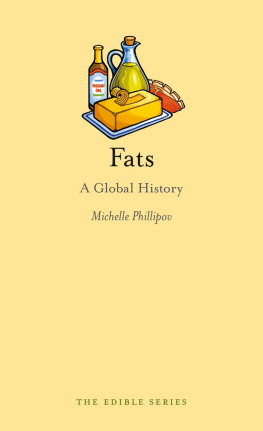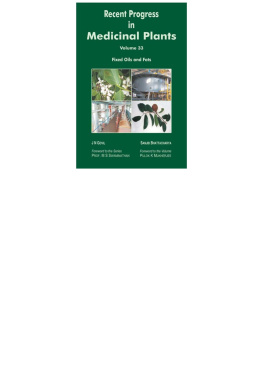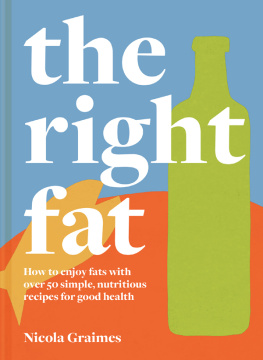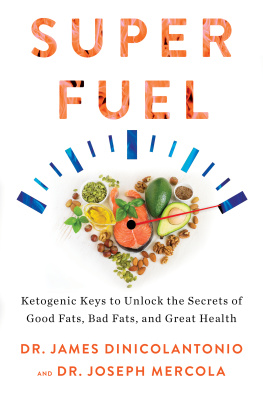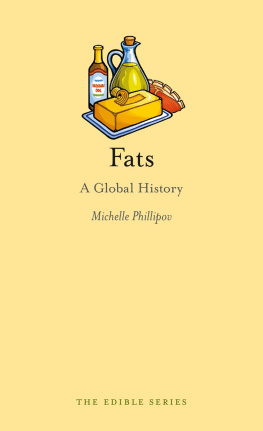FATS

Edible
Series Editor: Andrew F. Smith
EDIBLE is a revolutionary series of books dedicated to food and drink that explores the rich history of cuisine. Each book reveals the global history and culture of one type of food or beverage.
Already published
Apple Erika Janik Banana Lorna Piatti-Farnell
Barbecue Jonathan Deutsch and Megan J. Elias
Beef Lorna Piatti-Farnell Beer Gavin D. Smith
Brandy Becky Sue Epstein Bread William Rubel
Cake Nicola Humble Caviar Nichola Fletcher
Champagne Becky Sue Epstein Cheese Andrew Dalby
Chocolate Sarah Moss and Alexander Badenoch
Cocktails Joseph M. Carlin Curry Colleen Taylor Sen
Dates Nawal Nasrallah Doughnut Heather Delancey Hunwick
Dumplings Barbara Gallani Eggs Diane Toops
Fats Michelle Phillipov Figs David C. Sutton
Game Paula Young Lee Gin Lesley Jacobs Solmonson
Hamburger Andrew F. Smith Herbs Gary Allen
Hot Dog Bruce Kraig Ice Cream Laura B. Weiss
Lamb Brian Yarvin Lemon Toby Sonneman
Lobster Elisabeth Townsend Melon Sylvia Lovegren
Milk Hannah Velten Mushroom Cynthia D. Bertelsen
Nuts Ken Albala Offal Nina Edwards Olive Fabrizia Lanza
Onions and Garlic Martha Jay Oranges Clarissa Hyman
Pancake Ken Albala Pie Janet Clarkson
Pineapple Kaori O Connor Pizza Carol Helstosky
Pork Katharine M. Rogers Potato Andrew F. Smith
Pudding Jeri Quinzio Rice Renee Marton Rum Richard Foss
Salmon Nicolaas Mink Sandwich Bee Wilson
Sauces Maryann Tebben Sausage Gary Allen Soup Janet Clarkson
Spices Fred Czarra Sugar Andrew F. Smith Tea Helen Saberi
Tequila Ian Williams Truffle Zachary Nowak
Vodka Patricia Herlihy Water Ian Miller
Whiskey Kevin R. Kosar Wine Marc Millon
Fats
A Global History
Michelle Phillipov
REAKTION BOOKS
Published by Reaktion Books Ltd
Unit 32, Waterside
4448, Wharf Road
London N1 7UX, UK
www.reaktionbooks.co.uk
First published 2016
Copyright Michelle Phillipov 2016
All rights reserved
No part of this publication may be reproduced, stored in a retrieval system, or transmitted, in any form or by any means, electronic, mechanical, photocopying, recording or otherwise, without the prior permission of the publishers
Page references in the Photo Acknowledgements and
Index match the printed edition of this book.
Printed and bound in China by 1010 Printing International Ltd
A catalogue record for this book is available from the British Library
eISBN: 9781780236100
Contents

Introduction

Fats are essential for life. Along with protein and carbohydrates, they are the bodys primary sources of energy. But fats are not just about nutrition: they are also loaded with cultural and symbolic significance. To chew the fat; to butter someone up; fat cat; fat chance; to know which side ones bread is buttered; to grease ones palms; to lard ones prose; to look as if butter wouldnt melt in ones mouth; to pour oil on troubled waters In popular phrases and idioms, fats variously represent wealth, good favour, coldness, flattery and bribery. Perhaps more so than any other food, fats are ambiguous substances producing multiple meanings. These meanings have been contested throughout history, in global cuisines, in ongoing controversies about fats effects on health, in the practices of the food industry, and through the representation of fats in contemporary art, literature and popular culture. Fats have been understood as simultaneously commonplace and decadent, linked to both power and poverty, and associated with desire and with death.
While in common parlance fat is often synonymous with the fleshy corpulence of obesity, this book considers the uses and meanings of culinary fats: that is, the kinds that are ingested, rather than deposited on the body. As one of the three vital macronutrients, fats exist in every corner of the globe where humans can be found. They appear in a myriad of forms and derive from a variety of origins, including land and sea animals, seeds, fruits and nuts. Fats are a class of chemical compounds called triglycerides, which are formed by the union of glycerol and three fatty acids. If solid at room temperature, these triglycerides tend to be referred to as fats; if they are liquid at room temperature, they are normally called oils. Typically, animal sources produce fats, while plant sources produce oils (with the exception of fish, which also produce oils).
Humans obtain fats and oils through a variety of mechanical and industrial means, including agitation (to make butter, for example), rendering (as in duck fat), pressing (such as for extra virgin olive oil) and extraction (for example, rapeseed/canola oil). But despite the differences in production methods and appearance, the culinary purposes and nutritional qualities of fats and oils are often similar. Both preserve and lubricate food, bringing richness and desirable textures to a range of dishes, as well as a sense of satiety. They also act as flavour carriers, coating the tongue and holding the flavour on your taste buds; they dissolve essential vitamins (A, D, E, K) and aroma compounds that are insoluble in water; and they provide essential fatty acids, which the body cannot synthesize on its own. As a vital source of nourishment, fats are both ubiquitous and universal, but their culinary pleasure also makes them luxuries. This is a book about the extraordinary life simultaneously commonplace and remarkable, alternately banal and laden with meaning of culinary fat.
1
Power and Prestige: Fats in History

Fats are more than simply foods to be eaten. Throughout human history, fat has been a symbol to be wielded. Fats have been integral to the reinforcement and regulation of cultural, social, religious and economic values, simultaneously symbolizing and bestowing power, authority, luxury and distinction.
Humans larger brains and shorter digestive tracts mean that, biologically, we are much more dependent on nutrient-and energy-dense foods than other primates. At nine calories per gram, fat is much more energy dense than either protein or carbohydrate, which each consist of only four calories per gram. For most of the worlds hunter-gatherer societies, fats play a crucial role. In most traditional diets, fats comprise between 36 per cent and 43 per cent of the diet by caloric intake,game animals are especially lean excessive consumption of lean meat can result in a form of protein poisoning known as rabbit starvation, an agonizing and deadly condition in which sufferers experience intense pain and insatiable hunger. The Canadian explorer Vilhjalmur Stefansson, who spent many years with the native peoples of North America, observed their careful avoidance of overly lean meat, writing:

